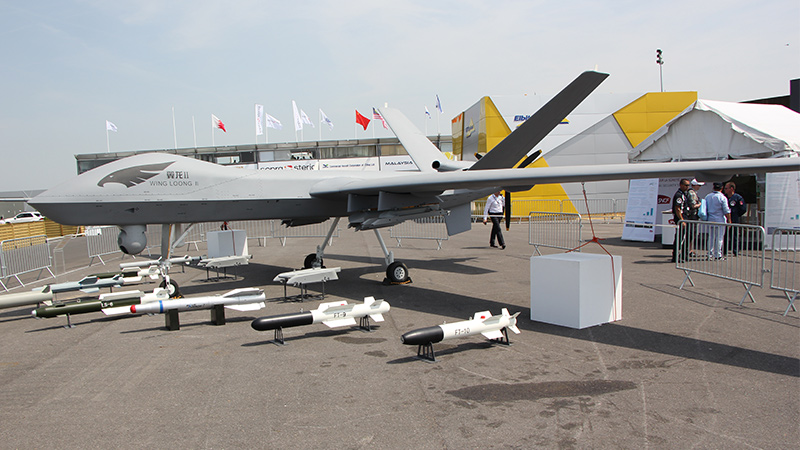Stay Up to Date
Submit your email address to receive the latest industry and Aerospace America news.
China’s Wing Loong 2 remotely piloted aircraft looks nearly identical to the MQ-9 Reaper, but U.S. analysts say the design lacks the engine power and flight range of the Reaper, highlighting the challenges facing China’s aerospace engineers as they work to match U.S. drone capabilities.
The Wing Loong 2s, built by a unit of the state-owned Aviation Industry Corp. of China, have a wingspan, height, length, rear propeller, front imaging pods and landing gear that are nearly identical to the MQ-9 Reapers built in Poway, California, by General Atomics Aeronautical Systems. Chinese state media calls the Reaper a close competitor to the Wing Loong 2, which translates as Pterodactyl.
Similarities between the two planes may be largely skin deep. Speed and endurance are key for remotely piloted aircraft, especially on reconnaissance missions, and China advertises that the Wing Loong 2 has a 370 kph top speed and can stay airborne for 20 hours. The General Atomics Aeronautical Systems website advertises superior engine performance for the Reaper, saying it has a top speed of 444 kph and can stay airborne for 27 hours.
“China’s drones look similar to American ones on the outside, but China often struggles to match U.S. capabilities in key subsystem technologies such as engine performance, communications and stealth,” says Paul Scharre, a senior fellow at the Center for a New American Security think tank in Washington, D.C., and a former policy official at the Office of the Secretary of Defense. The Chinese are making unmanned aircraft a priority, but the U.S. has an edge in real-world flying and fighting with drones.
The Reaper’s software for its sensors, pilot controls, missile aiming and data sharing was improved over the years and can’t be easily reverse-engineered, says Air Force Maj. Johnny Duray, who flew Reapers on combat and reconnaissance missions in Afghanistan, Syria and Iraq from 2014 until earlier this year. He is now a strategic policy fellow at the Air Force Association’s Mitchell Institute in Arlington, Virginia.
China and nations that might buy the Wing Loong 2 will also need instructors with years of experience piloting unmanned aircraft to train officers.
“There are a lot of things you have to learn and unlearn when you come from a manned background,” says Duray, who joined the Reaper program after flying conventionally piloted U-28A reconnaissance planes in Afghanistan and the Horn of Africa from 2009 to 2014. “You don’t get sensory feedback when accelerating like you do in a manned aircraft.”
Pilots must skillfully monitor screens in the Reaper ground control stations, and even pilots who did not transition from conventional aircraft need to learn to hit targets with missiles and maneuver the drones with the sometimes confusing controls, he says.
“If I was the Chinese and looking to improve the Reaper, I would say upgrade the human-machine interface,” says Duray.
The Wing Loong 2 would also sacrifice the battery power needed for long flights when it carries the maximum 12 missiles and bombs, Duray says. The Reaper can carry four air-to-surface missiles and two bombs, but launching them drains vital battery power, he explains.
Competing on weapons exports is among the potential benefits of imitating American designs, because the U.S. places limits on its sales of unmanned aircraft whereas China does not. The Wing Loong 2’s versatility for reconnaissance and combat missions is intended as a selling point for potential customers, says Elsa Kania, an adjunct fellow at the Center for a New American Security with expertise in Chinese military technology.
So far, Egypt, Iraq and Saudi Arabia have purchased the Wing Loong 2. China is not among the 35 nations that have signed the Missile Technology Control Regime created in 1987 to restrict exports of missiles and related technologies. The U.S., as a signatory of that agreement, limits its exports of remote piloted aircraft that carry missiles, which gives China an opportunity to market its aircraft as an option, especially if they look similar to U.S. models.
About Tom Risen
As our staff reporter from 2017-2018, Tom covered breaking news and wrote features. He has reported for U.S. News & World Report, Slate and Atlantic Media.
Related Posts
Stay Up to Date
Submit your email address to receive the latest industry and Aerospace America news.




